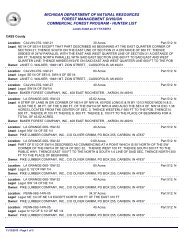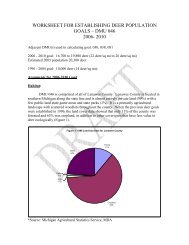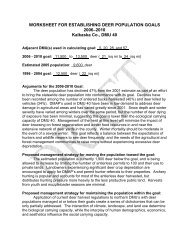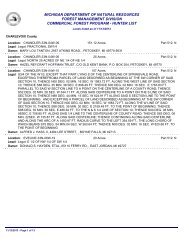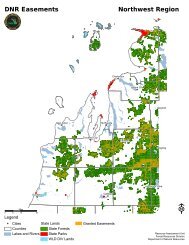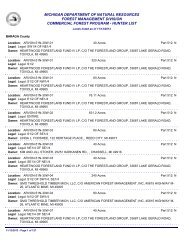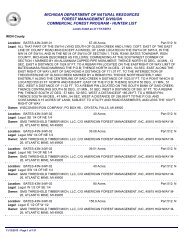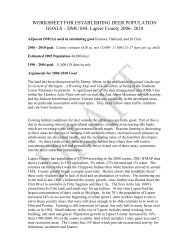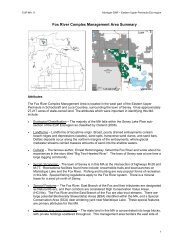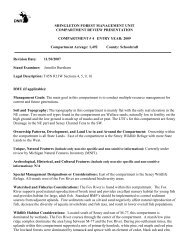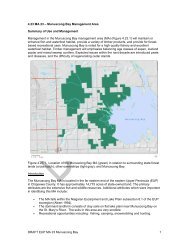DMU 067
DMU 067
DMU 067
You also want an ePaper? Increase the reach of your titles
YUMPU automatically turns print PDFs into web optimized ePapers that Google loves.
WORKSHEET FOR ESTABLISHING DEER POPULATION GOALS –2006 -2010Osceola Co., <strong>DMU</strong> <strong>067</strong>Adjacent <strong>DMU</strong>(s) used in calculating goal: 57, 54, 43,18, and 832006 – 2010 goal: 23,040 to 25920 deer (40/sq. mi to 45/sq. miEstimated 2005 population:23,492 deer1999 – 2004 goal: 25920 deer (45/sq. mi):Arguments for 2006-2010 Goal:The land in this <strong>DMU</strong> has been characterized by Denny Albert in the publication RegionalLandscape Ecosystems of Michigan…A Working Map and Classification, as being in theCadillac sub-subsection, of the High Plains subsection. This sub-subsection is characterizedpredominately by steep or irregular moraine topography or by either till or outwash plain. Basedon the 2001 IFMAP land use and land classification this <strong>DMU</strong> consists of the following: 3%urban, 24% agriculture, 17% herbaceous opening and upland brush, 41% upland forest, 11 %lowland forest, and 5% lowland non-forest. Four percent of the land is in public ownership.The goal for this <strong>DMU</strong> reflects the goal established during the development of the Deer RangeImprovement Program in 1971, for the old, ten county District 6 (Leelenau, Benzie, GrandTraverse, Kalkaska, Manistee, Wexford, Missaukee, Mason, Lake, and Osceola Cos.) . Newaygo,Mecosta, and Oceana Counties have subsequently been added to form the present NorthwestManagement Unit (NWMU). The distribution of deer across the ten county area was made basedon the deer habitat conditions and winter severity with higher deer goals established in the moresouthern counties of the District. These population goals were carried forward in the developmentof the Pere Marquette State Forest Plan, which again addressed the better habitat and milderwinter conditions in the more southern counties of the Management Unit.<strong>DMU</strong> 67 has a strong history of deer/crop damage complaints throughout the county andlandowners and farmers are very interested in deer management and deer hunting. However, inrecent years, with deer numbers at or below goal, agricultural complaints have dropped to one ortwo per year. Crop damage permits used dropped from 87 in 2000 to 5 in 2004. Car-deeraccidents have also decreased in recent years. They decreased from 1102 in 1999 to 591 in 2004.Concerns expressed in the late 1980’s and early 1990’s of the effect deer browsing was havingon forest regeneration, especially oak regeneration, were addressed by the construction ofexclosures in Lake and Osceola County. These exclosures were in mixed stands of aspen, oak,and red maple. Vegetation sampling of some of these exclosures in 1992, 5 years afterclearcutting, showed no difference in stem density or stem height between plots inside andoutside the exclosures. Other observations of recent cuttings in the <strong>DMU</strong> indicate that adequateregeneration of all tree species is occurring.Additional studies of deer-vegetation interactions in the NWMU are being planned. Forest,Mineral, and Fire Management Division (FMFMD) is preparing a couple of proposals to addressthe issue of oak and maple regeneration. Mammal exclosures will be used as part of a study to
factor out any potential impacts on regeneration by deer and other mammals. Althoughregeneration of forest species will be the primary concern of FMFMD, this project will provide anopportunity to evaluate the potential impact of mammals on ground layer vegetation also. Asecond project looking at deer-vegetation impact in the unit will be conducted by the Little RiverBand of Ottawa Indians. This research project, being funded by the U.S. Fish and WildlifeService, will be conducted in Manistee and Mason Counties. It will include the use of exclosuresto monitor both short and long term deer impacts on forest vegetation. Finally, the WildlifeAction Plan (formerly the Wildlife Conservation Strategy) is being used to identify deer issuesand associated research needs involving the NWMU. Research proposals will be developed toaddress these issues and will be submitted to the Wildlife Division for funding.Habitat programs have maintained high quality deer habitat across this <strong>DMU</strong>, both on both publicand private lands. Many private landowners are interested in deer habitat management and havedone various deer habitat management projects on their land. Deer survival during winter monthsis excellent and antler development reflects a healthy deer population.The goal for this <strong>DMU</strong> reflects the past history of hunters being relatively satisfied with deernumbers, agricultural complaints being at a minimum at this proposed level, and habitatssupporting these levels. Farmers, local residents, visitors, and nonresident recreationallandowners all enjoy seeing deer and the hunting opportunity they provide. A good mix of earlysuccessional timber types, mast producing trees, non-agricultural openings, conifer cover,drainages, and agricultural fields exist. Deer winter throughout the <strong>DMU</strong>. Many privatelandowners practice timber management on their properties, plant food plots, or feed deerthroughout the year.Proposed management strategy for moving the population toward this goal:Currently, the deer population in this <strong>DMU</strong> is at the low end of the goal. People are veryreceptive to harvesting both antlered and antlerless deer. Hunting pressure is very heavythroughout the county and deer numbers on public land will remain low because of that heavyhunting pressure. This hunting pressure on public land may drop off with lower deer numbersand allow the herd to rebound somewhat. On private land the issuance of over-the-counterprivate land permits and DMAPs will be used to maintain the herd at or below goal.The current harvest is resulting in an estimated overwinter or spring deer density of 28 deer persquare mile. The proposed goal for this <strong>DMU</strong> will result in a spring density of 28 to 31 deer persquare mile.Proposed management strategy for maintaining population within goal:The private landowners can control the antlerless harvest by controlling hunter access and the useof antlerless permits. The continued issuance of antlerless permits and DMAPs to landownerswill assist them in controlling deer numbers on private lands. On public land, where huntingpressure is heavier, it may be necessary to not issue any antlerless permits. The only antlerlessharvest would come from the archery antlerless harvest. If the population should go significantlybelow goal, it may be necessary to not issue any antlerless licenses.The continued collection of biological data, number of car-deer accidents, and number of DMAPsand the monitoring of deer numbers through Sex-Age-Kill Population modeling will assist inmaking management decisions.Goal relative to ownership patterns, habitat, and deer distribution:
Based on observations of department personnel and deer hunters, deer numbers are low on publicland. Public land hunters may control deer numbers by harvesting antlerless deer with archerylicenses even if public land antlerless licenses are not issued.The south and east side of the county has the most agriculture and larger deer population. Soilsare better in the east and south part of the county. The central, west, and north part of the countyhas fewer agricultural parcels. Land ownership in that part of the county is primarily forrecreational purposes. Sandier soils and frost concerns affect habitat conditions in these parts ofthe county.Goal relative to adjacent <strong>DMU</strong>’s within the Management Unit:<strong>DMU</strong> 54, Mecosta County, is very similar to this <strong>DMU</strong>. They both have a strong mix of goodagricultural areas and forest lands. As you go further north into northern Missaukee County,<strong>DMU</strong> 57, agricultural areas become fewer, soils become less productive, and the effects of winteron deer survival become more significant.DraftFinal DraftBiologist Larry Smith Larry SmithManagement Unit Supervisor Penney Melchoir Penney MelchoirField Operations Supervisor ___________________ __________________Wildlife Division Chief ___________________ __________________





